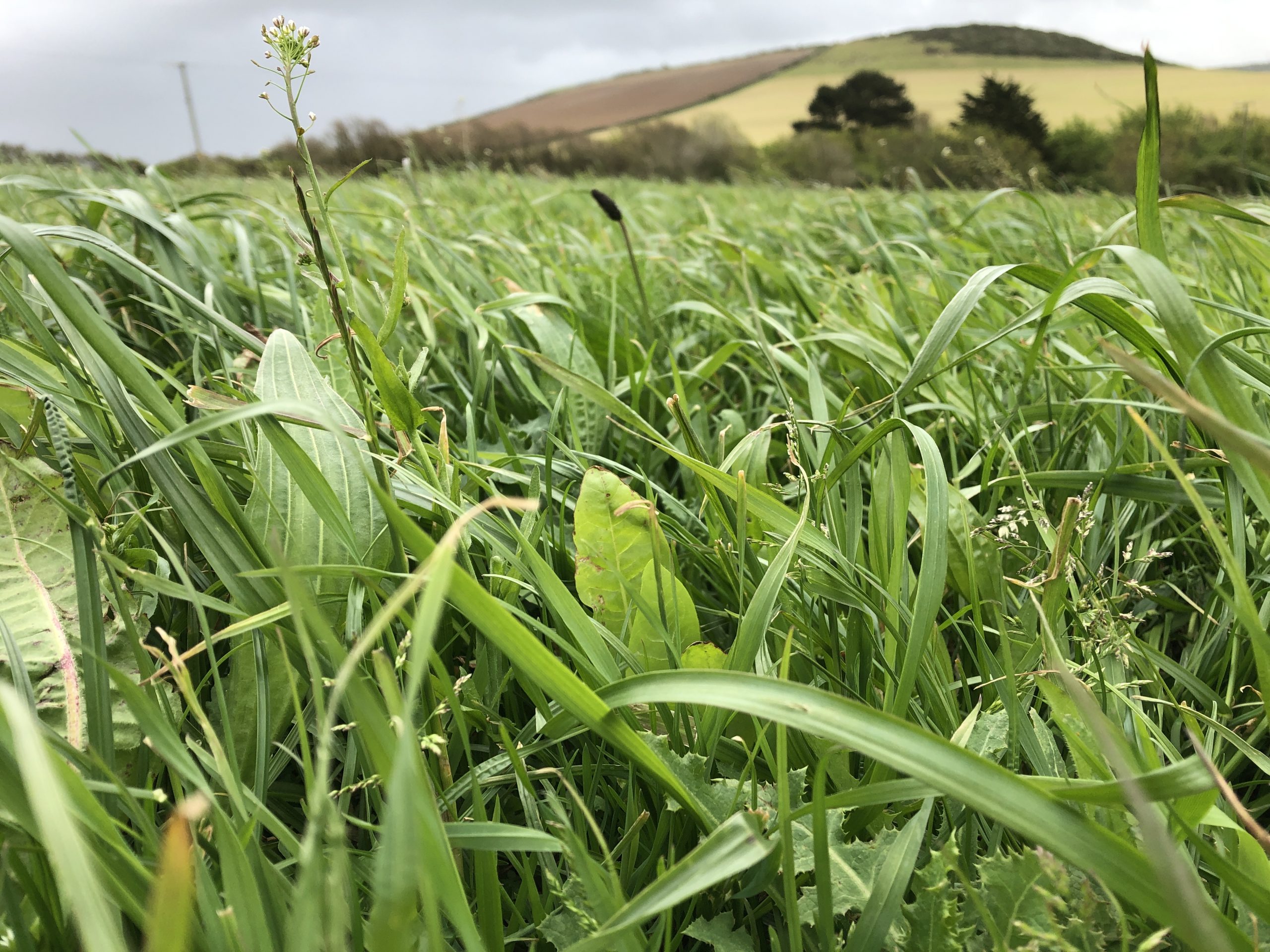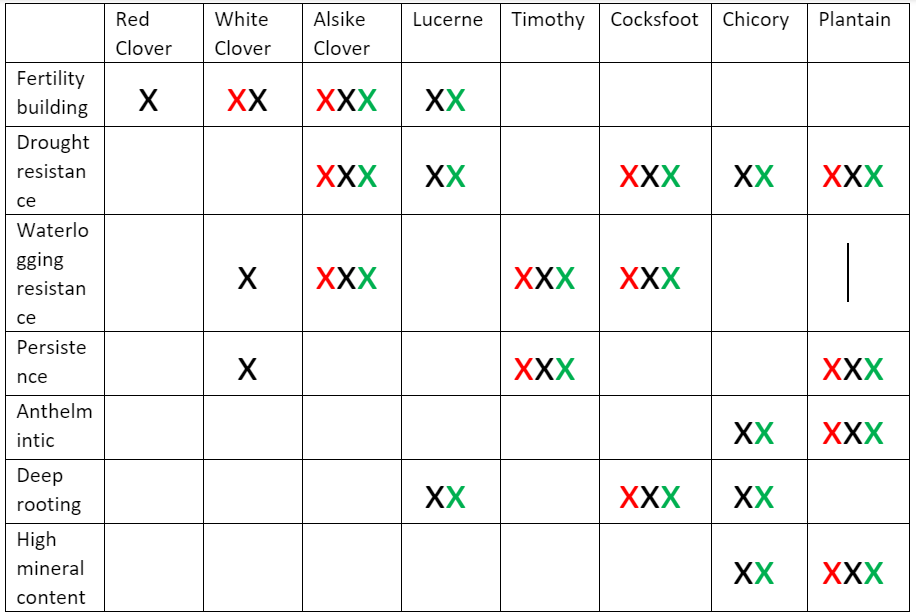Seed choice
A paragraph on each of the following: seed choice, establishment, grazing, ensiling, monitoring inputs; link to
Sophie’s seed cost work under ‘seed choice’ link to App under ‘seed choice’ and ‘monitoring’

Seed Choice
Herbal leys are simply composed of grass, forage legumes and herbs or forbs. They can be very simple and comprised of three species, but some you can buy can go up to 30 different species and varieties.
Market choice
We hit the internet to look at the choice available for farmers looking to buy seed for grazing and cutting lays in May 2020. We found:
36 companies
52.8% of companies offer MSS
512 mixes
8.01% of mixes were MSS
We selected 4 companies that offered a range of both binary and multispecies medium term mix types, with prices available online, for further investigation.
Between them, these companies offered a total of 26 multispecies and 40 binary mixtures.
[qcld_ichart post_id=”5276″]
[qcld_ichart post_id=”5278″]
Choosing your mix
The composition of your seed mix should reflect:
The growing environment (soil and climate)
Functions required
Management regime (what do you graze and how?)
Cost
Environment
When developing a herbal ley mix, the first thing to consider is your environment.
A mix for optimal environmental conditions
In an optimal environment where its warm with plenty of moisture and good fertility, for a very high yield you may start with your Italian rye grass which has extraordinarily high yields early in the season. If that area is to be grazed, you would add perennial rye grass as you get a much better season as far as yield is concerned. However, after 2 or 3 years, particularly in the more extreme environments, the persistence of perennial rye grass will fall and species such as timothy can be more useful. To safeguard against drought conditions, you may also consider adding cocksfoot for its drought tolerance.
Choosing a mix for conditions on farm
The more variable the environment and or management regime, the more species diversity you will require within your mix.
A sward that work for you
Similarly the more functions you wish to incorporate, the more species you will need to include.
You may want your sward to:
Improve soil fertility i.e. nitrogen fixation
Improve soils structure i.e. subsoilers
Reduce livestock worm burden
Reduction of weed burden without herbicide
Address nutrient deficiency in livestock
Management regime
Finally, you should consider management regime and end use.
Consider if you want peaks and troughs in production or a moderate production across the year.
Do you want to silage or graze the sward?
Cost
[qcld_ichart post_id=”5273″]
What about conventional vs organic?
the more unusual species (and particularly herbs) were substantially more expensive
Multispecies were, on average
Getting the right balance

Species may not perform well on all farms. For example, lucerne does not like acidic soil conditions. Therefore, if you were looking to build fertility, you would include white clover and alsike clover in the mix and leave out lucerne.
As multispecies sward seed mixtures are more costly than binary mixes, the mix needs to be well designed and optimally managed for farmers to experience the maximum possible benefits and get good value for money.
Building your mix
Add link to download seed cost calculator
The TOMS mix
The 17 species mix we trailed on our Cornish farms is not a typical mix. On average a commercially available conventional mix contains 10 species while an organic mix contains 11.
The benefit of our 17 species mix was that we were able to determine which species thrived on the conditions at each of our participating farms and which were not worth including in future mixes.
Average MMS mix typically contain 60.91% grass, 11.89% Herb and 27.18% legume and this is reflected in the TOMS mix.
[qcld_ichart post_id=”5268″]
[qcld_ichart post_id=”5271″]
Species establishment on Cornish farms
Herbal lay seed mixes typically cost more than a standard perennial ryegrass – white clover mix. As they are an investment, we need to be careful not to purchase species that will not establish under the conditions on farm. Our trail farms could save 3-27% of the total cost of their mix, simply by not purchasing the species that failed to establish in their next lay.
Meadow foxtail, sainfoin and self heal did not establish on the majority of the participating farm sites. Together these species represent 14% of the total cost of the mix (3%, 1% and 10% respectively). Cornish farmers may also want to think carefully about lucerne, salad burnet and sheeps parsley.
Species contribution to the ley
Different species present within the sward will differ in terms of their contribution. Some species may be present but in very low quantities, while others may be prevalent initially nd then their contribution to the sward reduces or even disappears entirely as time progresses. However, they could have value in the initial establishment of the sward.
Ryegrass for example declined throughout the season while plantain, chicory and white clover increased. The benefit of including ryegrass in the mix is that it is quick to establish providing quality cover early in the season.
The most prevalent species within our trial farm swards were chicory, plantain, ryegrass and white clover; each contributing 15% or more to the swards fresh weight.
Some of the species present in minimal quantities may also have a valuable contribution to the sward. For example, birdsfoot trefoil has anthelmintic properties, are nitrogen fixers, reduce methane emissions and are protein rich.


[qcld_ichart post_id=”5280″]
p=0.289 (Mann-Whitney U)
[qcld_ichart post_id=”5282″]
p=0.310 (Mann-Whitney U)
p=0.309 (adjusted for ties)
[qcld_ichart post_id=”5285″]
p=0.251 (Mann-Whitney U)
p=0.250 (adjusted for ties)
Trial and error
As every farm, and ever field is different, finding what works on your farm is often a process of trial and error. Further more, changing growing conditions means that what works one growing year, may not work the next. It is therefore important to experiment wisely and monitor the outcome.
At only 1% of the total cost, it is relatively cheap to experiment with sainfoin to determine if it is worth including in your sward. Sainfoin can be beneficial in reducing worm burden as a natural anthelmintic. It is also drought and frost tolerant and bloat safe. Providing your conditions are suitable, it can be a fantastic addition to a herbal ley.
Something like self heal is more costly to experiment with. It is worth talking to others in the area to find out what has and has not worked for them.
It is important to monitor the performance of species within the sward, the sward as a whole and it’s practical use (e.g. ensilability) under the farms management scheme. This will allow identify what works (or not) and to refine the mix to offer a better return on investment.
